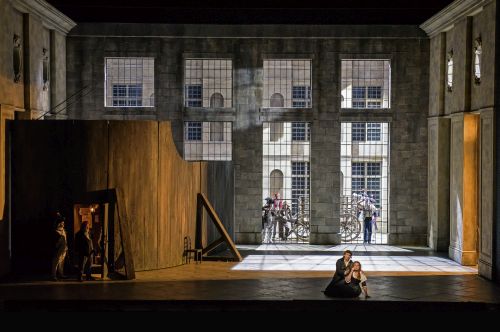 United Kingdom Pacific Northwest Ballet, “Don Quixote”: Marius Petipa, Alexander Gorsky and Alexei Ratmansky (choreography and staging); Dutch National Ballet (production); Elizabeth Murphy, Seth Orza, Otto Neubert, Jonathan Porretta, Sarah Ricard Orza, Jerome Tisser and Lesley Rausch (principals); Allan Dameron (conductor). McCaw Hall, Seattle, WA. 30.1.2015 (RC)
United Kingdom Pacific Northwest Ballet, “Don Quixote”: Marius Petipa, Alexander Gorsky and Alexei Ratmansky (choreography and staging); Dutch National Ballet (production); Elizabeth Murphy, Seth Orza, Otto Neubert, Jonathan Porretta, Sarah Ricard Orza, Jerome Tisser and Lesley Rausch (principals); Allan Dameron (conductor). McCaw Hall, Seattle, WA. 30.1.2015 (RC)
Dust had hardly settled on Alexei Ratmansky’s production of “Don Quixote,” premiered in Amsterdam by the Dutch National Ballet in 2010, when it was shipped lock, stock and barrel to Pacific Northwest Ballet, where it was given its local premiere two years later. The Russian choreographer came to Seattle—probably his first trip—to help set up the production here.
The libretto is a patchwork quilt taken from Cervantes’ celebrated novel, which by itself seems an awkward, if clumsy, series of scenes that don’t necessarily bind together into a cohesive and meaningful narrative. The story of the “errant knight” has had great allure for many choreographers in the past couple hundred years. The question is: how to fit dancing into the story. What is too much or too little? Choreographers differ, although the consensus now leans away from character development toward pure dance. Certainly the Petipa/Gorsky/Ratmansky reading places as much dance as possible on stage for three hours, which becomes rather like a long divertissement. The decor by Jerome Kaplan is conventional and pushes no boundaries, and the costumes, which he designed as well, are lush and colorful. James F. Ingalls provided the lighting.
Fortunately the company, plus professional level students in its school, are generally up to the task with only minor exceptions. Elizabeth Murray, who joined PNB in 2011 and was promoted to soloist last year, danced the role of Kitri. She is not a well-known member of the company, so “Don Quixote” represents a huge opportunity for her, and she fulfilled it. An astonishing dancer of great bravura, considerable style and immaculate technique, Murray compelled the eye to follow her, commanding the stage with razor sharp attacks and security. There was nothing sloppy or ill-considered in her movement, and everything was well-defined. It was a performance to remember.
Thehandsome Basilio was Seth Orza, who has been a member of the company since 2007 and is often given leading roles. He has grown into them with movement that is now more buoyant and confident. Otto Neubert, who often dances character roles, like Drosselmeier in “Nutcracker,” was adept at giving Don Quixote as full-bodied a personality as possible. Jonathan Porretta was predictably a marvelous Sancho Panza—broadly comic but not too much so.
Raphael Bouchard made poor Gamache a silly suitor to Kitri who was bound to fail, although limp wrists are now a bit of a cliche for these types of roles. Sarah Ricard Orza and Jerome Tisserand made the most of their secondary parts, dancing with panache and Spanish flavor, exhibiting well-articulated techniques. In the dream sequence, Lesley Rausch gave the Queen of the Dryads elegance and refinement.
The PNB Orchestra has become one of the company’s greatest assets. Allan Dameron conducted ably.
Richard Campbell
